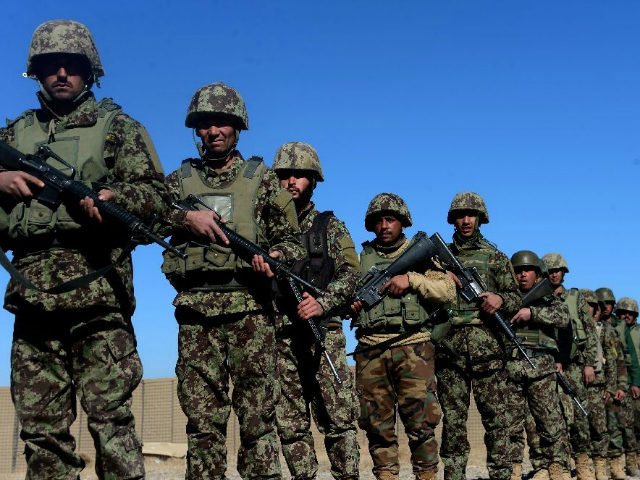The Trump administration is allegedly urging U.S.-backed Afghan forces to pull out of rural areas and focus on urban regions like the troubled capital of Kabul, home to a wave of attacks by the Taliban and its Islamic State rivals in recent months, the New York Times (NYT) reported over the weekend.
Meanwhile, the administration is also reportedly discussing an end to 17 years of war with the Taliban, negotiations long sought by the terrorist group and supported by a majority of Americans in public opinion polls.
Afghan ambassador to the United States Hamdullah Mohib, several unnamed Afghan commanders, and a Breitbart News review of the latest U.S. Department of Defense (DoD) assessment of America’s longest war contradicted the assertions made by the NYT on Friday.
Mohib denied that American-backed Afghan National Defense and Security Forces (ANDSF), including police and army units, are abandoning the rural areas and “essentially surrendering them to the Taliban.”
“The intent was not to withdraw, Mr. Mohib said in an email, but to first secure the urban areas to allow security forces to later focus on rural areas,” the New York Times reported.
“The strategy depends on the Afghan government’s willingness to pull back its own forces. A Defense Department official said some Afghan commanders have resisted the American effort to do so, fearing local populations would feel betrayed,” the Times added.
Despite these denials, three anonymous officials described classified documents to the Times that laid out a strategy for Afghan forces to fall back from “isolated and vulnerable outposts” in rural Afghanistan and focus on protecting major population centers, including the capital of Kabul.
In March, before President Donald Trump’s plan for Afghanistan was announced, Gen. John Nicholson, the top commander of American and NATO troops, conceded U.S.-backed forces would focus on protecting Kabul following a series of high-profile terrorist assaults at the hands of the Taliban and the Islamic State (ISIS/ISIL). Those attacks have since continued.
The NYT describes the Trump administrations alleged plan to “retreat” from rural Afghanistan and to focus on protecting key urban regions as “all but ensuring the Taliban will remain in control of vast stretches of the country.”
Citing “increased operations” during the period (December 1, 2017, through May 31, 2018) covered by its most recent assessment of the war, the Pentagon reported last month “the ANDSF [Afghan National Defense and Security Forces] successfully pushed the Taliban from population centers into rural areas and denied the Taliban their operational goal of capturing provincial centers.”
Nevertheless, the Pentagon noted that the fight against the Taliban in rural Afghanistan showed no signs of abating nearly a year after the Trump administration announced its strategy.
“The MoD [Ministry of Defense] continued to explore options to optimize the conventional ANA [Afghan National Army] and improve its ability to hold key terrain and protect the population in rural areas where the Taliban seek to gain influence,” the Pentagon pointed out.
In August 2017, U.S. President Donald Trump released his strategy to end the Afghan war, making “reconciliation” between the Taliban and the American-backed Afghan government its primary goal.
While the establishment media has blasted the current administration’s strategy for not producing results less than a year after it was unveiled, Trump’s predecessors drove Afghanistan’s descent into the chaos now inherited by the current president.
John Sopko, the top U.S. Inspector General for Afghanistan (SIGAR), a congressionally-created watchdog agency, has suggested the Trump strategy needs more time to take effect.
Optimism for peace negotiations grew following an unprecedented U.S.-backed three-day ceasefire between the Taliban and the Afghan security forces last month, its success attributed to the Trump administration’s strategy by officials in both Kabul and Washington.
For years, the Taliban has insisted U.S. and NATO troops must withdraw from Afghanistan as a precondition to peace talks. The United States has consistently refused this demand in public statements.
Until recently, the United States also denied the Taliban’s demand to engage in direct talks with Washington rather than the government in Kabul, which the terrorist group considers a “puppet” regime.
The U.S. has intensified diplomatic efforts to finally end the Afghanistan war and potentially pull out all but a residual force from the country, a move supported by a majority of Americans, according to polls conducted in the last few years.
In a dramatic departure from the position held by his predecessors, President Trump has reportedly urged senior U.S. diplomats to meet with Taliban representatives and discuss a possible truce, an approach also supported by the American public in polls.
Some reports claim Trump administration diplomats have met at least twice with Taliban representatives at the terrorist group’s diplomatic office in Qatar over the past few months. The Taliban claims the most recent meeting ending with “very positive signals” and could potentially lead to further discussions.

COMMENTS
Please let us know if you're having issues with commenting.